Since the launch of the first batch of CubeSats, on June 30, 2003, a total of 277 of these tiny satellites have been placed in orbit, either via a launch vehicle or deployed from the International Space Station (ISS).
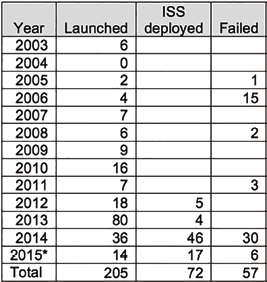
Number of CubeSats launched/deployed (* as of May 1, 2015)
At the time of this writing, 16 CubeSats were aboard the ISS awaiting deployment.
These 10x10x10 cm structures (or multiples thereof) were first advanced in 1999 by California Polytechnic State University (Cal Poly) in San Luis Obispo, California, and by Stanford University. They were seen as an instructive method of teaching science and engineering in a multi-disciplinary environment.
The objective was to build a satellite within a two- to four-year academic career period using Commercial Off-The-Shelf (COTS) components. Such was possible through the miniaturization of electronic components—a trend that continues unabated.
The early CubeSats were primarily built for educational purposes. In fact, if the small satellite was actually launched, such was considered to be a real bonus. While the early CubeSats were just that, 10x10x10 cm cubical structures referred to as 1U, before long various combinations were introduced, such as 2U and 3U as well as 1.5 U and 0.5 U. These variously sized units provided scientists with a structure that was optimized for the payload volume required for a specific project.

CSLI program
To promote, and to a certain extent, coordinate the development and launch of CubeSats in the United States, NASA introduced the CubeSat Launch initiative (CSLI) program in 2010. Satellites developed as part of this endeavor were eventually launched through the complementary Educational Launch of Nanosatellite (ELaNa) Program.
The CubeSat, sometimes also referred to as ‘nanosatellite,’ was, however, a concept that also captured attention beyond the academic world. These satellites provide excellent platforms and can be used to test technological concepts in space.
We are now at the start of the commercial use of CubeSats for communications, Earth Observation (EO) and for various meteorological purposes. There are also early proposals being introduced to use CubeSats for interplanetary missions.
There is also currently a move toward 6U units, comprised of two 3U units next to one another, as well as 12U units.
NASA hopes to send the first 6U CubeSat, named Dellingr, to the International Space Station (ISS) later in 2015 for deployment from that space platform in January of 2016.
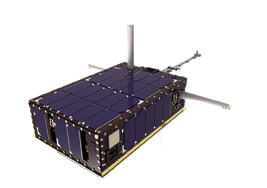
Artistic rendition of the Dellingr 6U CubeSat.
There are now various commercial suppliers in the market for CubeSat components, such as Innovative Solutions In Space (ISIS) of Delft, The Netherlands, who operates the on-line CubeSatShop.com as a one-stop-shop for CubeSat and nanosat systems. Clyde Space of Glasgow, Britain, also provides a similar service.
United Kingdom-based Alba Orbital markets the PocketQube Kit, which consists of the Alba Orbital Skeletonized structure that comes in 1p, 2p or 3p sizes. The 1p version is 5x5x5 cm and has a structural mass of 0.069 kg.
Pumpkin, a San Francisco based company, offers the CubeSat Kit, an affordable, off-the-shelf hardware and software development and deployment solution that includes complete, finished and ready-for-launch CubeSat structures in 0.5U, 1U, 1.5U, 2U
or 3U size.
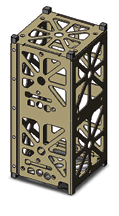
Clyde Space 2U frame.
But these projected large numbers of satellites, coupled to the readily available components, as well as their increasing size, possess certain problems that have to be overcome.
Launching The CubeSat
The earliest CubeSats were launched as additional payloads with a larger primary payload, that occupied some spare space in a rocket’s payload bay. Then with a random release, resulted into an orbit somewhat similar to the primary payload. This is expected to continue.
Proposed launch vehicles, such as NASA’s Space launch System (SLS), will most likely be fitted to accommodate future deployment of CubeSats. In the case of SLS, these CubeSats will be placed inside the upper stage adapter, where they will be exposed once the main payload, the Orion spacecraft, has been released 10 minutes after the launch. When the Orion is at a safe distance, the CubeSats will then be deployed.
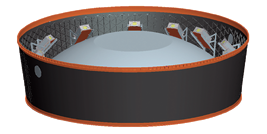
SLS CubeSat Deployer.
To gain some control over the release of these small satellites, devices such as the Poly-Picosatellite Orbital Deployer (P-POD) were developed as a means to deploy CubeSats from a range of launch vehicles.
The P-PODs can be mounted in the small, empty space of a launch vehicle. In example, a recent Atlas V launch managed 10 CubeSats of varying sizes, which were fitted into eight P-PODs. The P-PODS themselves were mounted in the Ultra Lightweight Technology and Research Auxiliary Satellite (ULTRASat), which was positioned at the aft end of the upper stage of the launch vehicle.
However, the P-POD only has the volume to hold 10x10x30 cm payloads. These means the P-POD can only deploy three 1U CubeSats, a 1U and 2U combination, or a single 3U CubeSat—the proposed 6U and 12U combinations could not be accommodated.
A large number of deployments have taken place with the JEM-Small Satellite Orbital Deployer (J-SSOD), such as in the Kibo module of ISS. In these instances, the CubeSats are brought up to ISS on one of the cargo spacecraft and are then deployed in a more or less controllable orbit.
However, with the number of nanosats or CubeSats to be launched in the coming years, a dedicated launch vehicle is certainly going to be required. Such a launch vehicle should be able to place a large quantity of CubeSats, perhaps 50 or more at a time, in orbit, to make such cost effective and into orbits better suited for their payload.
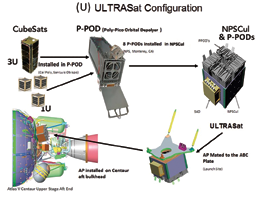
ULTRASat configuration.
One launch vehicle that, in the past, deployed large numbers of satellites on a single launch is the Russian/Ukrainian Dnepr 1, although this launch vehicle may not be available much longer. Apart from the fact that the Dnepr 1 is a converted missile, political situations could be a barrier to this vehicle’s use.
Although not a launch vehicle in its own right, Spaceflight Inc. is developing the SHERPA space tug, which allows secondary payloads, such as CubeSats, to be accommodated on a range of launch vehicles and, rather than being placed in the same orbit as the primary payload, they are into different orbits. The space tug offers five ports and a series of adapters to attach the various payloads, with a maximum capacity of 1,500 kg. The SHERPA will also have a propulsion system.
SHERPA will be built in two versions. The first one, the SHERPA 400, will accelerate a payload to a 400 m/s change in velocity, whereas the second and larger version, known as SHERPA 2200, will accelerate to 2,200 m/s. The SHERPA 400 is optimized for Low Earth Orbits (LEOs), whereas the SHERPA 220 will bring small satellites from a LEO to a geostationary orbit. The first use of the SHERPA is scheduled for 2015 when eight, as yet unnamed, CubeSats will be attached to a SHERPA vehicle that will be launched as a secondary payload on the Japanese Astro H mission. The company plans to provide two SHERPA mission each year, one being the SHERPA 400 and another the SHERPA 2200.
Closer to actually being a dedicated CubeSat launcher is the LauncherOne proposal that is being advanced by Virgin Galactic. Using the same infrastructure as their SpaceShipTwo, the company’s WhiteKnightTwo can carry the LauncherOne to altitudes of up to 15 km., the altitude at which the LauncherOne is released. Briefly free-falling before the first stage ignition, the two-stages vehicle will deliver payloads into LEO.
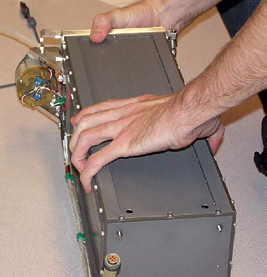
P-POD
In May 2015, NASA requested industry proposals for the agency’s Venture Class Launch Services (VCLS) program, which seeks to launch 60 kg. of CubeSats simultaneously at a fixed price. The expectations are that a contract will be granted by September 30, 2015, and that the launch will occur before April 15, 2018.
Only time will tell if any of the above launch proposals will be selected, or if a new contender in this increasingly important market niche will be selected.
Applications
As stated before, applications being devised for CubeSats are becoming more and more varied.
Planetary scientists have already proposed that a number of CubeSats of varying size be carried on missions to the Moon, asteroids, comets or other planets. Once the main spacecraft is in the vicinity of a celestial body, a number of nanosatellites will be deployed to take part in a wide range of exploratory objectives. Deployment could be as individual satellites or as constellations. The low cost and the large number of CubeSats would reduce the risk of mission failure, while also allowing exploration of a much greater area. NASA has already started the Cube Quest Challenge, a competition for the development of CubeSats to fly to the Moon and beyond on the first Orion flight, which will be launched by the SLS rocket.
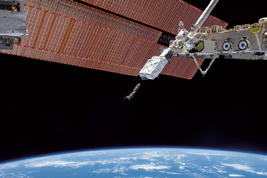
Nanorack Deployer (J-SSOD).
NanoSwarm is a proposal from University of California at Santa Cruz for a swarm of more than 30 CubeSats around the Moon. They will observe the body’s interaction with the solar wind, study strange localized magnetic swirls, and track the movement of water across the airless lunar surface. If accepted, this 10 month mission could be launched in February of 2020.
The European Space Agency (ESA) has announced they will accommodate two 3U CubeSats on the proposed Asteroid Impact Mission (AIM), which is scheduled for launch in October 2020. Once the CubeSats have eventually been selected, they will boost and complement the main mission. In addition, the intention is to use the CubeSats to test intersatellite communications networking. In a similar manner, NASA’s Europa Clipper, scheduled for launch in 2022, may carry a number of CubeSats that will be deployed in orbit around the Jovian moon.
Within the EO environs, Planet Labs has taken the lead with its Flock series of satellites, a constellation of 28 EO CubeSats. These 5 kg. 3U satellites will provide 3 to 5 m resolution images of the Earth from the equator to 52 degrees latitude. To date, 63 of these satellites have been deployed—11 were launched on a Dnepr 1 launch vehicle, the remainder from facilities aboard ISS. Fourteen satellites remain on ISS to still be deployed, while a batch of 26 satellites did not orbit as a result of the failure of the Antares launch vehicle on October 28, 2014.
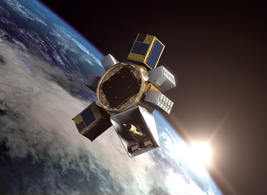
Artistic rendition of SHERPA.
One of the problems with the Flock series is, however, that these small satellites do not remain in orbit for extended periods of time. As of this writing, 40 Flock satellites have experienced an average on orbit time of 135 days. To maintain this constellation, many more launches will be required.
San Francisco based company Spire, formerly known as NanoSatisfi Inc., intends to establish a constellation consisting of as many as 100 CubeSats to provide data on weather and climate changes on a global basis. The satellites will be fitted with High Resolution Sensors that measure the GPS signals through Earth’s atmosphere to calculate temperature, pressure, and humidity with a high accuracy and resolution. The expectation is that this satellite constellation will have to be upgraded every two years in order to maintain pace with changing technology. Once operational, the system is expected to provide, by the end of 2015, five times more data than current systems, 10 times the amount of data by the end of 2016, and more than 100 times the data by the end of 2017.
The space communications industry has also advanced some proposals for the commercial use of CubeSats. The U.S. company Outernet has teamed with Clyde Space of Scotland to develop a 200 1U CubeSat telecommunications constellation to provide low-cost broadband to remote regions of the world. This project is sponsored by the UK Space Agency, with funding provided through its International Partnership Space Program (IPSP) that funds British companies to work with international partners developing satellite technology.

Virgin Galactic’s WhiteKnightTwo.
Additionally, Dunvegan Space Systems (DSS) has signed a contract with Deep Space Industries (DSI) for the construction of 24 3U CubeSats for a communications constellation.
Specific mention should be made of the QB50 project proposed by the von Karman Institute for Fluid Dynamics (VKI) in Belgium. The QB50 project consists of 50 2U and 3U CubeSats in a worldwide program for long-duration measurements in the lower thermosphere that is intended to greatly increase the knowledge and understanding of the E and F layers of the ionosphere. In addition, the satellites will carry out research experiments on re-entry and perform in-orbit demonstration of the newly developed technologies. The project was officially kicked off in November of 2011.
The CubeSats are to be constructed by universities all over the world. The plan is that all 50 satellites will be launched in 2015 via a single launch vehicle and be placed in circular orbit of between 350 and 380 km. altitude, with an inclination of 98.6 degrees. The satellites will be separated in orbit by natural atmospheric drag forces and they will form a uniform network around Earth within about three weeks. The vision is that 34 CubeSats would be provided by European universities in 19 countries, 11 by universities in the U.S., two by universities in Canada and three by Japanese universities. After the call for proposals was made in February 2012, the VKI Project received proposals for 81 CubeSats from 41 countries.
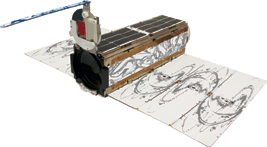
Spire’s Flock CubeSat.
CubeSats and pocket-cubes, with their relatively low cost, provide opportunities to institutions and individuals that, without them, would not be able to develop satellites. For instance, the Superior Institute of Technologies and Applied Sciences (InSTEC) and of the Polytechnic Superior Institute José Antonio Echeverría (Cujae), Havana, Cuba, has started with the construction of the CubaSat-1 satellite. In Australia, a single individual is developing the OzQube-1 satellite. Unfortunately, due to the limited availability and the high cost of launch opportunities, these projects remain Earthbound.
However, the increasing number of CubeSats has also raised concern about the increase of space debris in frequently used orbits, such as the polar orbits and the ISS orbit. As these secondary payloads are being placed in the same orbit as the primary payload and cannot be removed from those orbits, they pose, at the end of their missions, a threat to the primary payloads in similar orbits. Indeed, some CubeSats are now testing de-orbit devices that will reduce their orbital parameters.

Small satellites, such as CubeSats and pocket CubeSats, are here to stay and they can be expected to increase in number. In fact, there are some estimates that as many as 2,750 CubeSats could be built and launched over the next five years.
Jos Heyman is the Managing Director of Tiros Space Information, a Western Australian consultancy specializing in the dissemination of information on the scientific exploration and commercial application of space for use by educational as well as commercial organizations. An accountant by profession, Jos is the editor of the TSI News Bulletin.

